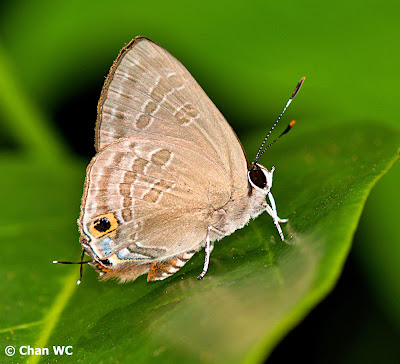The Eliot's Cornelian (Deudorix elioti)
An Eliot's Cornelian perched on a leaf at the forest edge of Singapore's nature reserves
We are into the second half of the year 2023, and we are experiencing record high temperatures and unprecedented climate phenomena in many countries in the northern hemisphere. Extreme floods hit other parts of the world, damaging properties and killed people. Did some clueless politician once say that climate change is a figment of scientists' and climatologists' imagination? The month of July belongs to the astrological sign Cancer. For those born between 22 June and 22 July, your zodiac sign is Cancer. We featured Capricorn, Aquarius, Pisces, Aries, Taurus and Gemini in the preceding Butterfly of the Month blogposts and will now move into the next in the series. The 12 zodiac signs are Aries, Taurus, Gemini, Cancer, Leo, Virgo, Libra, Scorpio, Sagittarius, Capricorn, Aquarius, and Pisces.
Even as far north as Beijing in China, the mercury reached record values. The temperature in Beijing breached 41 degrees Celsius last month and shattered the record for the hottest day as heatwaves that had seared northern China a week earlier returned to the Chinese capital. Having travelled to Beijing in December and January before, I recall seeing snow on one of my trips there in winter, and yet hearing about 41 degree summers is quite unimaginable!
Cancer (♋︎) (Greek: Καρκίνος, romanized: Karkínos, Latin for "crab") is the fourth astrological sign in the zodiac, originating from the constellation of Cancer. Water is the element associated with Cancer, and, alongside Scorpio and Pisces, it forms the water trigon. The water trigon is one of four elemental trigons in the zodiac, with the other three being fire, earth, and air.
Positive Cancerian traits include being helpful, patient, compassionate, nurturing, romantic and creative. They tend to be extremely caring generous, putting the needs of others before their own. They are generally very patriotic, waving the flag whenever possible. Cancerians thrive in roles where there is a lot of communication and where they can constantly engage with colleagues. However, if embarrassed, they can also withdraw into their crab shell and lose steam very quickly.
Difficult traits of the Cancer sign include being a busybody and gossipy, form cliques and shuts out people they dislike, or become isolated and uncommunicative when they are shamed. They can also be hypersensitive, overly competitive and bossy in environments where they want to control and dominate over.
The Butterfly of the Month for July 2023 is the rare Eliot's Cornelian (Deudorix elioti). However, it is widely distributed in Singapore and has been seen in various locations and even in urban parks and gardens. It is more frequently seen along the forest edges of our nature reserves. In the past two years, it has been observed more frequently and even common for a short period of time. On a particular day at the Lornie Park Connector, three mating pairs of The Eliot's Cornelian were seen in the same vicinity!
A male Eliot's Cornelian sunbathes and shows its coppery-red uppersides
It is a rapid flyer and can fly at tremendous speeds amongst the shrubbery. The male of the Eliot's Cornelian is quite similar to the Cornelian (Deudorix epijarbas cinnabarus) but the red is duller and there is an obscure series of post-discal spots on the hindwing. The female is distinctive in having faint brown markings in the tornal half of the hindwing.
The underside of the species is a light grey, with rounded post-discal spots faintly outlined in white. The tornal area of the hindwing below has bluish-green iridescent scaling and there is a white-tipped tail at vein 2. The abdomen is black-and-white banded on the underside. The eyes are jet black and the antennae bears a bright orange tip at the club.
The early stages of the Eliot's Cornelian is currently unknown and if the caterpillars are like the Cornelian, they are likely to be also feeding on the fruits of various plants like the pomegranate (Punica granatum) and on the seeds of Aesculus indica and other species of Sapindaceae and Connaraceae.
Text by Khew SK : Photos by Chan WC, Ash Foo, Khew SK, Michael Khor, Loh MY, Jess Loh, Ong LM, Michael Soh, Horace Tan and Tay JX





























































